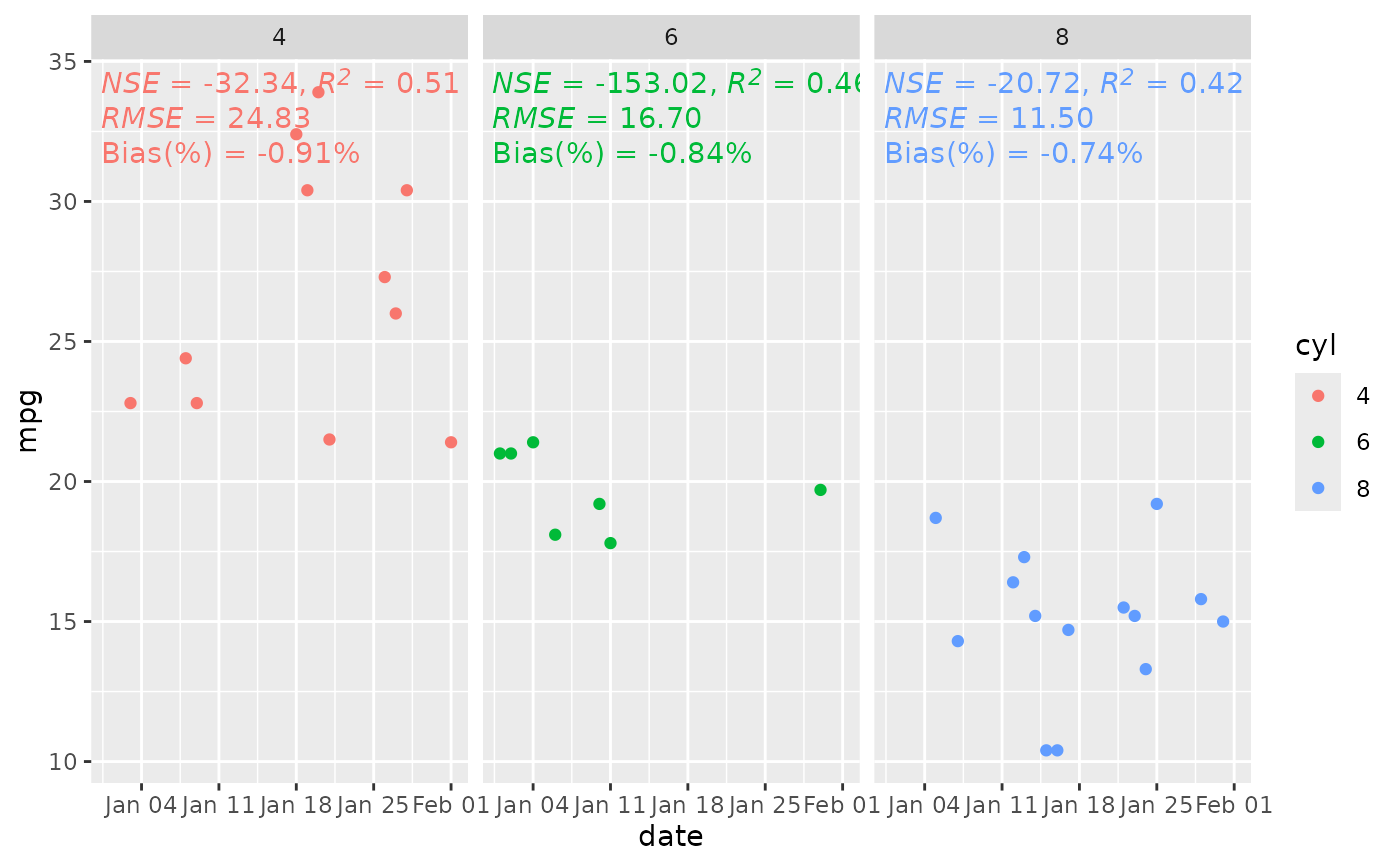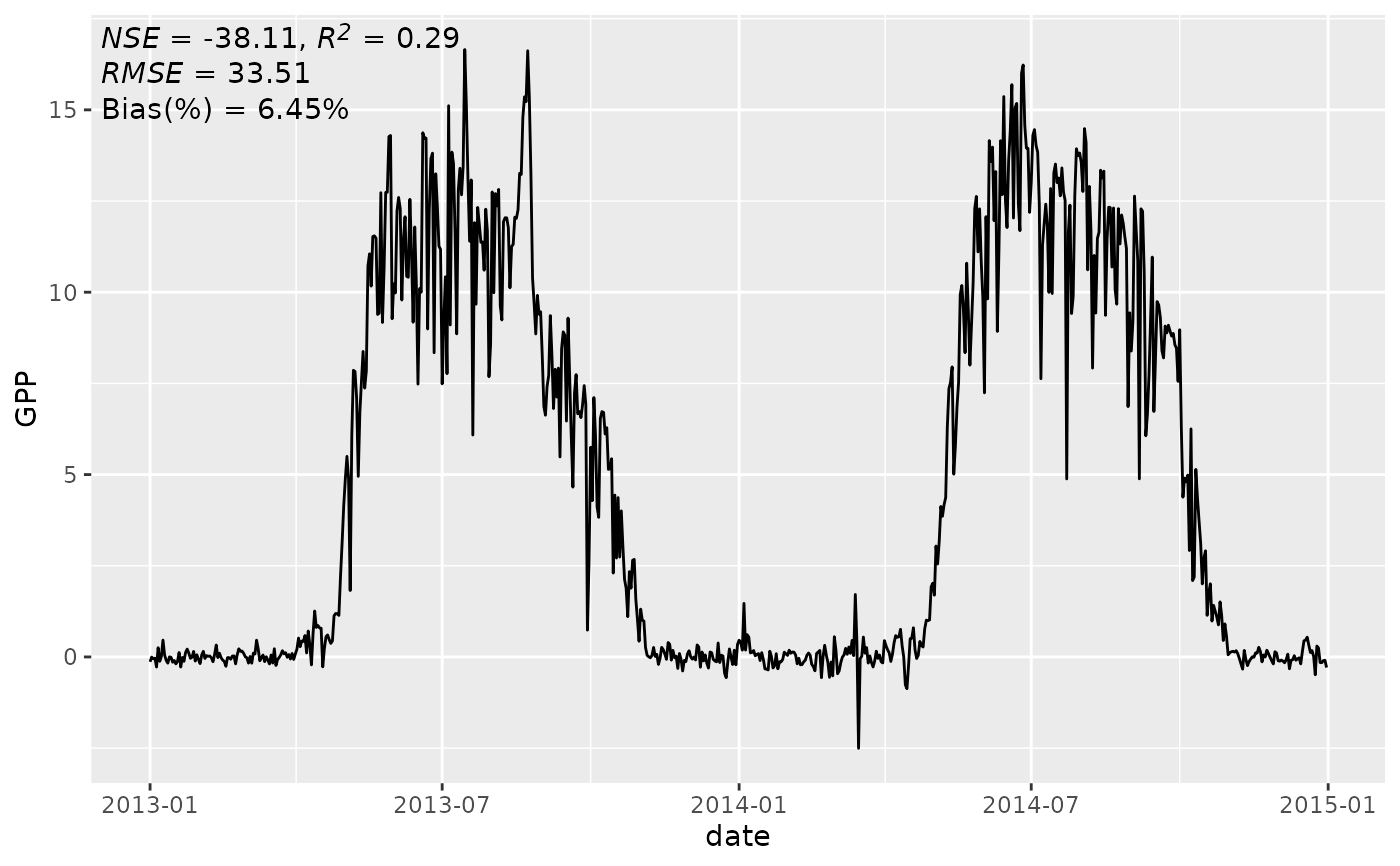stat_gof2
stat_gof2.Rdstat_gof2
stat_gof2(
mapping = NULL,
data = NULL,
geom = GeomRichTextNpc,
position = "identity",
na.rm = FALSE,
show.legend = NA,
show.bias = TRUE,
label.format = fmt_gof,
x = 0.05,
y = 0.95,
inherit.aes = TRUE,
...
)
geom_gof2(
mapping = NULL,
data = NULL,
stat = StatGOF2,
position = "identity",
...,
show.bias = TRUE,
label.format = fmt_gof,
eval.flood = FALSE,
x = 0,
y = 1,
hjust = 0,
vjust = 1,
size = 5,
na.rm = FALSE,
show.legend = NA,
inherit.aes = TRUE
)Arguments
- mapping
Set of aesthetic mappings created by
aes()oraes_(). If specified andinherit.aes = TRUE(the default), it is combined with the default mapping at the top level of the plot. You must supplymappingif there is no plot mapping.- data
The data to be displayed in this layer. There are three options:
If
NULL, the default, the data is inherited from the plot data as specified in the call toggplot().A
data.frame, or other object, will override the plot data. All objects will be fortified to produce a data frame. Seefortify()for which variables will be created.A
functionwill be called with a single argument, the plot data. The return value must be adata.frame, and will be used as the layer data. Afunctioncan be created from aformula(e.g.~ head(.x, 10)).- position
Position adjustment, either as a string, or the result of a call to a position adjustment function. Cannot be jointy specified with
nudge_xornudge_y.- na.rm
If
FALSE, the default, missing values are removed with a warning. IfTRUE, missing values are silently removed.- show.legend
logical. Should this layer be included in the legends?
NA, the default, includes if any aesthetics are mapped.FALSEnever includes, andTRUEalways includes. It can also be a named logical vector to finely select the aesthetics to display.- label.format
default value:
"*NSE* = {str_num(NSE,2)}, *R^2* = {str_num(R2, 2)} \n *RMSE* = {str_num(RMSE,2)}".label.formatwill be evaluated byglue::glue(). Variables inside{}will be evaluated. All variables returned byGOF()are supported.- x
A numeric vector or unit object specifying x-values.
- y
A numeric vector or unit object specifying y-values.
- inherit.aes
If
FALSE, overrides the default aesthetics, rather than combining with them. This is most useful for helper functions that define both data and aesthetics and shouldn't inherit behaviour from the default plot specification, e.g.borders().- ...
Other arguments passed on to
layer(). These are often aesthetics, used to set an aesthetic to a fixed value, likecolour = "red"orsize = 3. They may also be parameters to the paired geom/stat.- stat
The statistical transformation to use on the data for this layer, as a string.
Value
No return. This function is used to calculate data for gglot2
geom_*, just like ggplot2::stat_smooth().
required axes
obs: observedsim: simulated
Examples
library(ggplot2)
library(data.table)
dates <- seq(as.Date("2010-01-01"), length.out = 32, by = "day")
dat <- data.table(mtcars) %>% cbind(date = dates, .)
dat$cyl <- as.factor(dat$cyl)
# table(dat$cyl)
ggplot(dat, aes(date, mpg, color = cyl)) +
stat_gof2(aes(obs = mpg, sim = wt), x = 0, y = 1) +
geom_point() +
facet_wrap(~cyl)
 ## Example 2
dat = GPP_US_MMS
ggplot(dat, aes(date, GPP)) +
geom_line() +
stat_gof2(aes(obs=GPP, sim=SM), x = 0, y = 1)
#> Warning: Removed 44 rows containing non-finite outside the scale range (`stat_gof2()`).
## Example 2
dat = GPP_US_MMS
ggplot(dat, aes(date, GPP)) +
geom_line() +
stat_gof2(aes(obs=GPP, sim=SM), x = 0, y = 1)
#> Warning: Removed 44 rows containing non-finite outside the scale range (`stat_gof2()`).
 ##
dat = data.table(
obs = c(10, 12, 15, 14, 13, 16, 18, 20, 19, 22),
sim = c(11, 13, 14, 15, 12, 17, 17, 21, 20, 20),
sim2 = c(11, 13, 14, 15, 12, 17, 17, 21, 20, 25),
group = rep(c("A", "B"), each = 5)
)
showtext::showtext_auto()
#> Error in loadNamespace(x): there is no package called ‘showtext’
library(Ipaper)
#> Error in library(Ipaper): there is no package called ‘Ipaper’
fmt_gof <- "*NSE* = {str_num(NSE,2)}, *R^2* = {str_num(R2, 2)}"
p = ggplot(dat, aes(obs, sim)) +
geom_point() +
stat_gof2(aes(obs = obs, sim = sim), x = 0, y = 1, eval.flood = TRUE, show.bias = FALSE, label.format = fmt_gof, size = 6) +
stat_gof2(aes(obs = obs, sim = sim2), x = 0, y = 0.9, eval.flood = TRUE, show.bias = FALSE, label.format = fmt_gof, size = 6)
write_fig(p, "d:/Rplot.pdf", 10, 5)
#> Error in write_fig(p, "d:/Rplot.pdf", 10, 5): could not find function "write_fig"
##
dat = data.table(
obs = c(10, 12, 15, 14, 13, 16, 18, 20, 19, 22),
sim = c(11, 13, 14, 15, 12, 17, 17, 21, 20, 20),
sim2 = c(11, 13, 14, 15, 12, 17, 17, 21, 20, 25),
group = rep(c("A", "B"), each = 5)
)
showtext::showtext_auto()
#> Error in loadNamespace(x): there is no package called ‘showtext’
library(Ipaper)
#> Error in library(Ipaper): there is no package called ‘Ipaper’
fmt_gof <- "*NSE* = {str_num(NSE,2)}, *R^2* = {str_num(R2, 2)}"
p = ggplot(dat, aes(obs, sim)) +
geom_point() +
stat_gof2(aes(obs = obs, sim = sim), x = 0, y = 1, eval.flood = TRUE, show.bias = FALSE, label.format = fmt_gof, size = 6) +
stat_gof2(aes(obs = obs, sim = sim2), x = 0, y = 0.9, eval.flood = TRUE, show.bias = FALSE, label.format = fmt_gof, size = 6)
write_fig(p, "d:/Rplot.pdf", 10, 5)
#> Error in write_fig(p, "d:/Rplot.pdf", 10, 5): could not find function "write_fig"